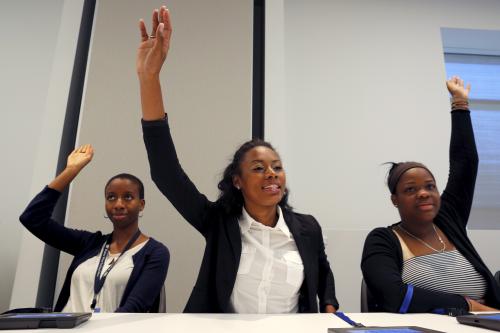This is the final piece in a six-part blog series on teaching 21st century skills, including problem solving, metacognition, critical thinking, and collaboration, in classrooms.
When we think about communication skills, we most frequently focus on expressive skills—what does one say? How does one say it? However, in reality, communication is a two-part process with an expression component and a reception component. The unheard and unseen aspects of both parts are the assumptions that are made both by the communicator and the recipient. These assumptions can both facilitate or obstruct the clarity of the message. In this blog, we focus on the reception component of communication—listening—and how our assumptions can affect our interpretation of what we hear.
What is listening? In the context of communication, it is not merely being sensitive to sound; it is interpreting and contextualizing the sound. It is important, as a recipient to be aware of your frame of reference when listening. Does your interpretation of what you hear interfere with the intent of the communication?
To illustrate this, we have included the following story to be listened to (the written script is available at the end of the post). Experiencing often communicates better than being told! Imagine telling this story to a small group of students.
The Fretting King
Part 1
Take a break and ask questions like:
» How is the room?
» What does the king look like?
Prompt students to provide details: Is the king tall/short, fat/slim? What is he wearing?
It will become apparent how our frame of reference, which might include stereotypes, experiences, and knowledge influence imagination. For example, from the brief part of the story already told, it may be that students see the king as in a historical movie and the room as in a turreted castle.
Part 2
Take a break and ask questions like:
» What does the queen look like? Her age?
» What is she wearing?
» What does the room look like now?
There will be a variety of responses, of course, with, for example, eye colors from blue to brown, clothing from velvet to gold, and perhaps additional details about the room, revealing students’ assumptions and possibly stereotypic views.
Part 3
Take a break and ask questions like:
» What does the king look like now?
» And the queen?
Have the descriptions changed? Someone’s king will have grown a beard; someone else’s will have turned from young to old. Note that even if the king is now patently old, students may not shift to see an old queen. People react differently to unexpected events in the flow of knowledge. Some maintain their initial interpretation, while others react more flexibly.
Part 4
Take a break and ask questions like:
» What does the room look like now?
» And the people?
Cardboard, scissors…something is going in an unexpected direction. Are the students willing to make a dramatic change in their imagination?
Part 5
Take a break and ask questions like:
» What does the room look like?
» And the people?
» What could the object be?
» Does this change what you imagined?
How has what the students are picturing changed? Are they willing to abandon completely what they had built in their minds? Which pieces of the story have they saved and which have they abandoned?
This is the end of the story. Conclude with a group discussion to review how the students approached the activity, what facilitated shifts in perceptions and understandings, and what they might have learned.
This is the story Nicoletta uses with her students. It’s an “aha” experience for all concerned—revealing to students in the higher education sector how much their understandings are influenced by their personal frames of reference.
The experience helps to understand that:
- the listener is not passive but active;
- she creates interpretations of the message based on her assumptions, knowledge, experience, tastes. This may cause misunderstanding if the two “interpreters” (the expressive and recipient) do not match; and
- she may be vulnerable to manipulation.
So what does it truly take to listen? Whether you answered the story questions yourself or asked your students, you will have realized the vast number of assumptions that we make based on a small number of stimulus words. We “jump to conclusions” rather than think critically, and this can lead to unintended consequences.
We can teach students a couple of strategies to develop their critical questioning of their frame of reference. First, they need to be aware of the influence of their assumptions, so exercises like the one above can be useful. Second, they need to be aware of the perspective that the expressive communicator brings to the situation. So, a strategic lever is what is called “perspective taking”. For clarity of communication, students need to take into account both their own perspectives and those of others. The frame of reference of the expressive partner and the frame of reference of the recipient are important signposts to acknowledge if the “truth” of communications is to be realized.
THE FRETTING KINg script
Part 1
Our story begins with a king. The king was pacing up and down the big throne hall, with a worried look on his face. The prime minister told him, “Do not fret, your majesty. They will arrive on time, for sure.” “I’m not sure at all!” boomed the king. “That’s exactly what you told me before! And they have not come yet!” The prime minister backed out shyly, afraid of the king’s temper. The weather was also becoming worse, as it could be seen out of the tall windows of the hall. The light of the sun was no more as bright as it was before.
Part 2
At that moment, the door of the throne hall opened, and there came in the beautiful queen. She reached the king with a sympathetic look on her face asking, “Are they coming?” “Do not even ask me”, grumbled the king, with a gloomy face. “Those incompetent fellows….” The queen shot him a kind glance, and she took some steps back and sat on a wooden chair with a red cushion.
Part 3
The king took a look at his watch, and the look on his face grew even gloomier. “We are running late. I knew it.” He stroked his long white beard and said thoughtfully, “We might go to the duke’s house.”
Part 4
But, right at that moment, some steps were heard outside, and the door opened. There came in two men. One of them was carrying a small cardboard box. The queen said cheerfully, “They have made it!” and immediately produced a pair of scissors to cut the sticky tape that sealed the box. All the people in the room gathered around the two men who were struggling to open the box as soon as possible.
Part 5:
Within the box, there was a small object and some papers that looked like a short “instructions for use” manual. On them, some letters were visible: “M…O…B…I…L…E”






Commentary
The mysteries of communication: What does it take to really listen?
January 10, 2018